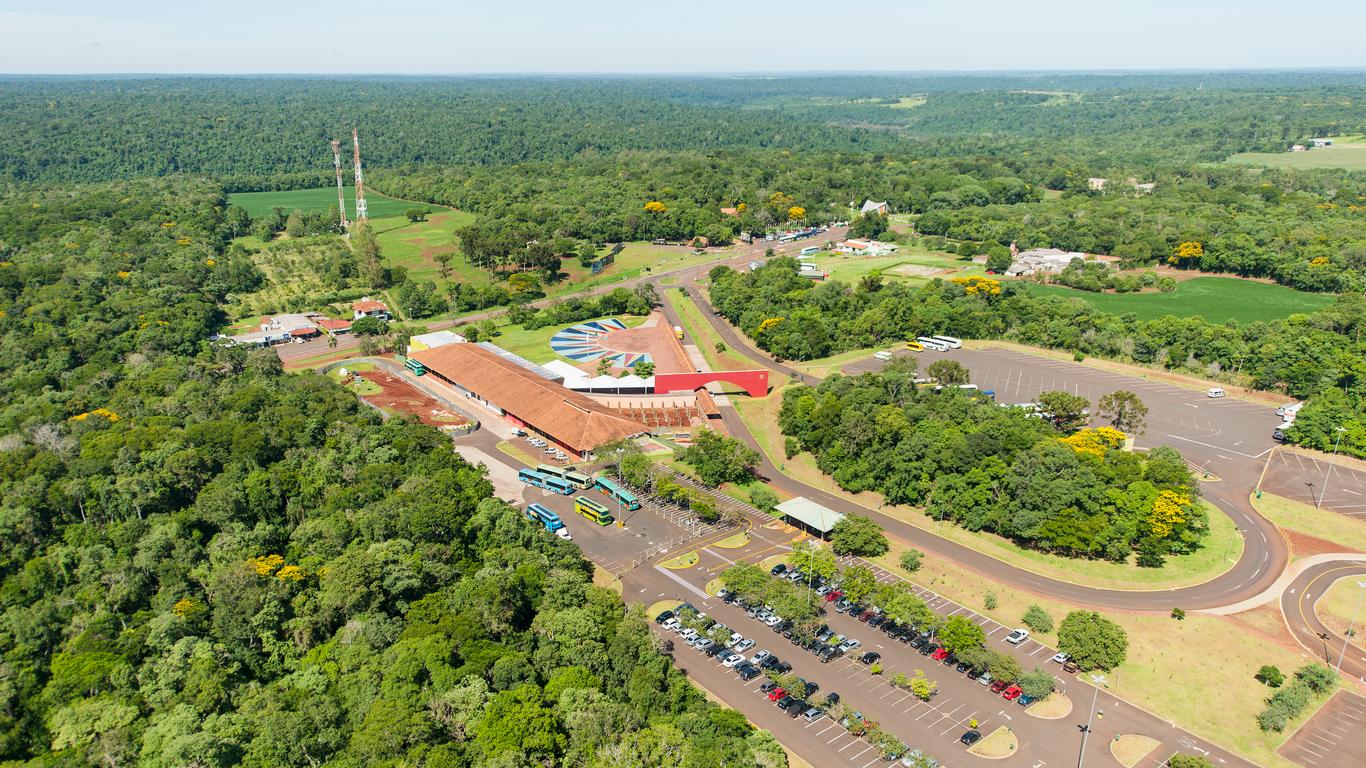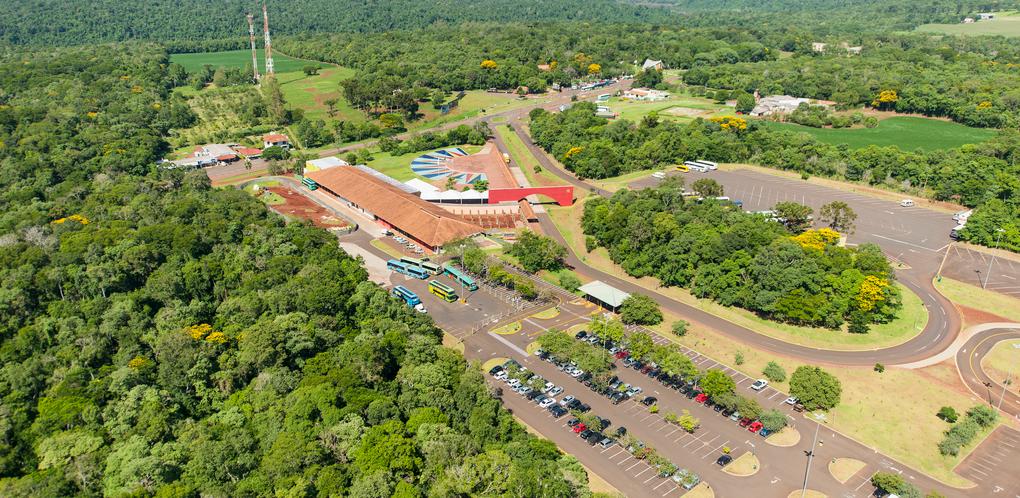
Foz do Iguaçu travel guide
Foz do Iguaçu Tourism | Foz do Iguaçu Guide
You're Going to Love Foz do Iguaçu
Foz Do Iguacu is situated on the border between Brazil, Argentina, and Paraguay and by the stunning Iguazu Falls. The falls are one of the world's most awesome sights and the surrounding rivers and rainforests contribute to a spectacular natural setting.

Top 5 Reasons to Visit Foz do Iguaçu
1. Iguazu Falls
You cannot come to Foz Do Iguacu without seeing the Iguazu Falls. They can be admired from viewpoints on the Argentinian or Brazilian sides and by helicopter or boat.
2. Itaipu Dam
The Itaipu Dam is the largest hydroelectric dam in the world and also the largest electricity generator. Tours allow you inside the dam to view the massive turbines.
3. Three Borders Landmark
This is the unique spot where three nations meet. Visitors can see Brazil, Argentina, and Paraguay all in one place.
4. Parque das Aves
The Parque das Aves is a bird watcher's paradise, with more than 180 species in this ecological sanctuary.
5. City Tour Foz Do Iguaçu
The City Tour Foz Do Iguaçu is a great way to get to know the city and the surrounding sights.
What to do in Foz do Iguaçu
1. The Niagra Falls of Brazil
The breathtaking Iguaçu Falls on the border of Brazil and Argentina include 275 drops that descend from the Iguaçu River. The falls were discovered in 1541 by a Spanish Conquistador named Álvar Núñez Cabeza de Vaca. They are now part of the the Iguaçu National Park in Brazil and the Iguazú National Park in Argentina, both UNESCO World Heritage Sites. Taller than the Niagara Falls and twice as wide, the Iguaçu Falls feature walkways that allow visitors to enjoy their awe-inspiring power up close.
2. Three Borders Mark: An International Intersection
The point where the Iguaçu and Paraná rivers meet is named Three Borders Mark and defines the borders of Argentina, Brazil, and Paraguay. A yellow and green obelisk at the site built in 1903 conjure up the colors of the flag of Brazil. From the mark, visitors can take spectacular pictures of the riverscape. The location also features a memorial to Álvaro Nunez Cabeza de Vaca, the first European to explore the falls. The area also has a café and a shop that sells local arts and crafts. Hotels offer guided tours of Three Borders Mark and transportation is readily available to and from the site.
3. Buddhist Temple: A Garden of Tranquility
The Buddhist Temple of Iguaçu on the banks of the Paraná River is a striking homage to Buddhist architecture. Situated on 42 acres of lush tropical gardens, the temple was built by the Asian community of Iguaçu in 1996 to pay tribute to the diversity of Brazil. The site features over 120 sculptures, including a seated Buddha that overlooks the river. Other designs include four bodhisattvas riding elephants and dragons. A place for meditation, the temple also affords its visitors panoramic views of the city. There is no charge for visiting the temple and transportation runs to and from the site frequently.
4. Itaipu Dam: Spectacular Sustainability
Designated one of the Seven Modern Wonders of the World by the American Society of Civil Engineers, the Itaipu Dam is a hydroelectric dam situated on the Paraná River between Brazil and Paraguay. The dam produces the most hydroelectric power in the world. Construction began in 1975, creating a lake with 29 billion tons of water. The dam began operations in 1983 and today reigns as a symbol of sustainability in an increasingly fragile world.
5. Paróquia São João Batista: Spiritual Simplicity
A simple and discreet cathedral, the Paróquia São João Batista dates back to the early 20th century. The site was formerly occupied by a church that burnt to the ground in 1925. In its place, the cathedral began construction in 1940 and was completed in the 1970s. The décor, though simple, is striking. The light-colored walls are adorned with paintings and religious figures, and the beautiful stained-glass windows radiate in the morning sun. Mass is held every day at noon and again in the early afternoon.
1. The Niagra Falls of Brazil
The breathtaking Iguaçu Falls on the border of Brazil and Argentina include 275 drops that descend from the Iguaçu River. The falls were discovered in 1541 by a Spanish Conquistador named Álvar Núñez Cabeza de Vaca. They are now part of the the Iguaçu National Park in Brazil and the Iguazú National Park in Argentina, both UNESCO World Heritage Sites. Taller than the Niagara Falls and twice as wide, the Iguaçu Falls feature walkways that allow visitors to enjoy their awe-inspiring power up close.
2. Three Borders Mark: An International Intersection
The point where the Iguaçu and Paraná rivers meet is named Three Borders Mark and defines the borders of Argentina, Brazil, and Paraguay. A yellow and green obelisk at the site built in 1903 conjure up the colors of the flag of Brazil. From the mark, visitors can take spectacular pictures of the riverscape. The location also features a memorial to Álvaro Nunez Cabeza de Vaca, the first European to explore the falls. The area also has a café and a shop that sells local arts and crafts. Hotels offer guided tours of Three Borders Mark and transportation is readily available to and from the site.
3. Buddhist Temple: A Garden of Tranquility
The Buddhist Temple of Iguaçu on the banks of the Paraná River is a striking homage to Buddhist architecture. Situated on 42 acres of lush tropical gardens, the temple was built by the Asian community of Iguaçu in 1996 to pay tribute to the diversity of Brazil. The site features over 120 sculptures, including a seated Buddha that overlooks the river. Other designs include four bodhisattvas riding elephants and dragons. A place for meditation, the temple also affords its visitors panoramic views of the city. There is no charge for visiting the temple and transportation runs to and from the site frequently.
4. Itaipu Dam: Spectacular Sustainability
Designated one of the Seven Modern Wonders of the World by the American Society of Civil Engineers, the Itaipu Dam is a hydroelectric dam situated on the Paraná River between Brazil and Paraguay. The dam produces the most hydroelectric power in the world. Construction began in 1975, creating a lake with 29 billion tons of water. The dam began operations in 1983 and today reigns as a symbol of sustainability in an increasingly fragile world.
5. Paróquia São João Batista: Spiritual Simplicity
A simple and discreet cathedral, the Paróquia São João Batista dates back to the early 20th century. The site was formerly occupied by a church that burnt to the ground in 1925. In its place, the cathedral began construction in 1940 and was completed in the 1970s. The décor, though simple, is striking. The light-colored walls are adorned with paintings and religious figures, and the beautiful stained-glass windows radiate in the morning sun. Mass is held every day at noon and again in the early afternoon.
Where to Eat in Foz do Iguaçu
You will find lots of steak restaurants in town, with the Brazilian churrascarias particularly popular. Churrascaria do Gaúcho on Avenida República Argentina is a local favorite, with mains from R$28.50. Boi Na Brasa on Av. Juscelino Kubitschek is a good budget choice, with a buffet from R$8.
When to visit Foz do Iguaçu
Foz Do Iguacu has a subtropical climate with hot summers and warm temperatures in spring and fall. It can get quite cold and even frosty in winter (April to September).
How to Get to Foz do Iguaçu
Plane
Foz Do Iguacu/Cataratas International Airport (IGU) has frequent flights from other South American cities. A taxi into town costs around R$55 and the number 120 bus is R$3.20.
Car
The BR-277 is the main route from Curitiba, while the BR-116 connects the city with Rio de Janeiro and Sao Paulo.
Bus
There are regular buses to Foz Do Iguacu from other Brazilian cities and also from Buenos Aires. The bus from Rio de Janeiro takes 24 hours and costs R$240.
Airlines serving Foz do Iguaçu
Where to stay in Foz do Iguaçu
Vila Paraguaia - this is a leafy area close to the city center on the banks of the Paraná River.
Popular Neighborhoods in Foz Do Iguacu
Portal Da Foz - this is an area to the east of the city center, with a number of hotels, bars, and restaurants.
Jardim Panorama - this is a busy area of shops and bars to the south of the city center.
Where to stay in popular areas of Foz do Iguaçu
Most booked hotels in Foz do Iguaçu
How to Get Around Foz do Iguaçu
Public Transportation
Local buses run across the city, with fares from R$3.20.
Taxi
Foz Do Iguacu has plenty of taxis, with the meter drop at R$5.45; from then prices are R$4 per mile.
Car
Car rental is available in the city from R$85. Roads in the city are generally in good condition, although surrounding routes can be in a slightly poorer state.
The Cost of Living in Foz do Iguaçu
Shopping Streets
Avenida Brasil is the busiest shopping street in Foz Do Iguacu, with everything from fashion to toys, electronics, and souvenirs. The Sunday street market on Avenida Juscelino Kubitschek is a good place for local crafts.
Groceries and Other
A quart of milk in Foz Do Iguacu is priced at R$2, while a loaf of bread will cost R$4.
